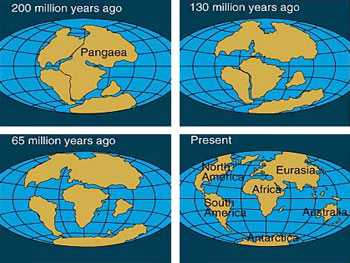Continental Drift. These maps show a succession of two or even three different supercontinents, stretching back over a thousand million years. Not surprisingly the evidence gets increasingly uncertain as we go back in time. The Continental shift schedule is a fast rotating shift pattern that uses 4 teams and three 8-hr shifts to provide 24/7 coverage. Each team rotates through a sequence of 2, 2, and 3 consecutive day shifts, swing shifts, night shifts, or days off. The following is a typical team schedule for a 4-week (28 days) repeat cycle.
A TIMELINE FOR THE PLANETclickfor
These maps show a succession of two or even threedifferent supercontinents, stretching back over a thousand million years.Not surprisingly the evidence getsincreasingly uncertain as we go back in time.However scientists believe that there were several more even earlier supercontinents – at more or less 500 millionyear intervals – stretching back until the planet was young.

[Click for:RodiniaPangaea


We’ve all heard of Continental Drift by now, with thedifferent land masses wandering all over the globe.To begin with it was just theory.
Geologists and Palaeo-geographers have worked out howthe landmasses have moved in the past – how they have clumped together to formsuper-continents, and then split up again and gone their separate ways.
The maps
These maps don’t show the actual shape of thecontinents in times past.Neither couldthey.A lot of land has certainly beeneroded away since, and more will have been deeply buried under other land – as
These images simply show the believed disposition ofpresent land masses at the time.
There are thought to have been at least 3supercontinents, even earlier than the ones we depict below, stretching backmore than 2½ thousand million years.This was the heyday of bacteria, when they were the only lifearound.
The hard evidence for these early supercontinents islong gone.But every 500 million yearsor so geologists have spotted signs of mountain building episodes, as theindividual landmasses came together.Mountain building is happening today in various places.The most spectacular is the
Rodinia
It was the late Proterozoic when life was stillentirely microscopic – and of course very much all underwater.
The orange patches are mountain-building areas,and the hatched areas are where there aresigns of rifting.As we keep saying,don’t expect things to be simple in this game.
The rest of the maps all come from Christopher R.Scotese’s Paleo mapping project (www.scotese.com).
Panotia
Apparently it was complete around 550 million yearsago.However instead of going on to jointhe rest of the land to produce a proper supercontinent, it seems to havebroken up again during the Cambrian (as we’ll see).
The very late Proterozoic is also the time of theterrible Varangerian ice age.Signs of glaciation have
Cambrian
This is the world around the time of the greatCambrian explosion (more) around 500million years ago.That was when largecreatures suddenly appeared on the scene, apparently out of nowhere.
Panotia was well on the way to breaking up.
Ordovician
This is the Ordovician Period 460 million yearsago.Not a lot happens on the platetectonics front in a mere 40 million years – although maybe the landmasses arebeginning to get a little closer again.
Note the external ocean (more).It’s the same as today’s Pacific, rechristened as the Panthalassa Ocean.
The mid Ordovician is the time of the GreatDiversification, when sea-floor-dwelling filter feeders exploded into thegreatest diversification of all time (more).Shortly after, round about the lateOrdovician, the plants invaded the land.It was also one of the coldest times in Earth history, unless youbelieve the full blown ‘Snowball Earth’ theory (more).
Silurian
This is the middle Silurian, 435 million yearsago.There are now definite signs thatthe next supercontinent, Pangaea, is beginning to build.
Not shown on this map are the increasing areas ofshallow sea around the margins of the continents (I got this from anothermap).I’ve read that this is what youwould expect at this stage.
It is around the time that the animals invaded theland.High sea levels would be just whatwas needed to give them a leg up!
Pangaea
The amount of shallow sea has dropped, as thesea-floor gets old and cold.ThePacific/Panthalassa Ocean is of course still there.And we still have one large internal ocean, theTethys Sea.
These were hard times.The large land mass generated widespread deserts, and the oxygen levelfell.
Shortly before this had come one of the greatest massextinctions of all time, the P-T event (more).

Jurassic
This is the early Jurassic.We can see that Pangaea is beginning to breakup.
The climate was much warmer than today, and stayed sountil the K-T extinction that killed off (most of)the dinosaurs.
The early Jurassic was the start of the dinosaurs’heyday – shortly after the Triassic extinction had killed off most of thecompetition.Primitive mammals found aniche for themselves too, but it was a pretty insignificant one.
Cretaceous
This is the late Cretaceous.The break-up of Pangaea is complete.
The Cretaceous climate was still balmy, right up tothe poles.Dinosaurs and palm treeslived in both polar regions.
Sea level was 100-200 metres higher than today, whichcreated plenty of shallow seas as the continental margins were flooded.They provided plenty of channels whereby warmwater could be transported towards the poles.
Today
The past 60 million years or so have been a period offairly frenetic continental collision and mountain-building.India hit Asia. Spain hit France. Italy hitFrance & Switzerland.Greece andTurkey hit the Balkan region. Arabia hit Iran and Australia hit Indonesia.
Nextsupercontinent
And this is the world predicted for 250 million yearshence.It represents the final stages ofthe building of the next supercontinent – or possibly the early stages of itsbreak-up.Australia/Antarctica arestill/again separate from the main land mass.
The north Atlantic has closed up again, though in adifferent way from the past.Inparticular Britain and Scandinavia have drifted north, and joined northernRussia on the edge of the Pacific (or possibly the Arctic/Pacific) Ocean.The south Atlantic has become a large inlandsea and India and south-east Asia join up.

How do theyknow?
The main weapon in the palaeo-mapper’s armoury is‘palaeo-magnetism’.
Most if not all rocks are very slightly magnetic.They contain minute specks of iron oxide, andthese act like little compasses.(Ifthis reminds you of magnetic tape or computer media then full marks.
If the rock should get melted then these littlecompasses are free to align themselves with the Earth’s magnetic field – justlike your hiking compass does (not quite actually as we’ll see).When the rock solidifies again these littlecompasses get locked in position.Theyprovide a recording of where North was at the time of solidification.
Something else important happens at the sametime.The atomic clock gets reset (more).Thismeans that the mappers also have the date on which the ‘recording’ wastaken.
Equally important, the recordings tell the mappers thelatitude of the place where the recording was taken.
It works like this.An ordinary compass pretends that the Earth’s field runs along theground.But it only actually does thisnear the Equator.Everywhere else itdips downwards.And the further north orsouth you are, the greater the angle of ‘dip’.At the poles, the field dips straight down vertically, and an ordinarycompass is useless.
An ordinary compass only measures the ‘horizontalcomponent’ of the Earth’s field, because that’s what most of us want.Its dial is supported on a single pinbearing.It you put the compass on itsside the dial slips off.But
Any large land mass will have many sites where therock has suffered re-melting, and made its recordings.Hopefully the recordings will cover a widerange of dates.This enables the mappersto plot the movement of the land mass, north and south.
Unfortunately there’s no such simple tool formeasuring movement east and west.Getting a handle on this involves detailed detective work and much trialand error.
However the geologists can often tell when landmassescame together and split apart and this helps a great deal.For example, if they find a geologicalstructure in Antarctica that is identical to one they’ve already seen in Canada(I think I have the example right) then they must once have been adjoined.
But that’s not all.The palaeontologists can often identify fossils that are identical onparts of two widely-separated masses.They must once have been adjoined too.And again the palaeontolgists can often estimate when this was.
It has taken many decades for Scotese to come up withhis definitive maps.And not allpalaeo-mappers agree with him even now.
© C B Pease, January 08
Summary
The heat from inside the Earth causes the material of the mantle to permanently rise up along the ocean ridges, resulting in the formation of a dense basaltic crust which slowly rolls away from the ridge, much like a rug being rolled up. The continents, which are made of an insubmersible lightweight crust, passively drift with the movement of the lithospheric plates on which they sit.
The animation illustrates the movements of the lithospheric plates from 250 million years in the past through to the present, as well as projections of continental movements 30 million years into the future.
Click on button to see the position of lithospheric plates today.
Rollover the continents to see the names of the lithospheric plates.
Click on or to play/stop the animation.
Learning goals
- To illustrate the arrangement and movements of the lithospheric plates on the Geological Time Scale.
- To study of the evolution of lithospheric plates’ positions, from Pangea to the present, as well as an extrapolation of their positions in the distant future (30 MY).
Continental Shift Ocean
Learn more
Continental Shifts Definition
Due to the interior heat of the Earth, material in the mantle rises to the level of the oceanic ridges, creating a permanent, dense basaltic crust that moves slowly like a baggage carousel. The…
